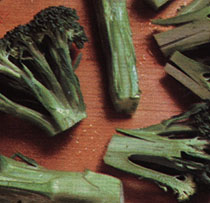
FoodFood InformationVegetablesCabbage Family
Broccoli, the Italian branch of the cabbage family, was not widely known
or used in the United States until about 25 years ago. In 1920 Stephen and
Andrew D'Arrigo planted trial fields of broccoli in California using seeds
imported from Italy. Today, America's largest grower of broccoli is D'Arrigo
Bros. Co., which farms more than five thousand acres near Salinas. The surrounding
area from Santa Barbara to just below San Francisco produces almost 90 percent
of the nation's annual production. Broccoli loves the the coastal belt cooled
consistently with blankets of fog. Sixty years ago fresh broccoli could
be purchased only in Italian neighborhoods. Today it is one of our best-selling
fresh, as well as frozen, vegetables.
While California is by far the number one producer of fresh broccoli, substantial
crops are produced in Texas, Oregon, and Arizona. Fresh broccoli is available
twelve months of the year, with the peak of season from October through
May. The light part of the season is usually July and August, but supplies
are usually adequate to meet the demand.
When shopping for broccoli, the key words are firm and green. The undesirable
words are limp and yellow. Top quality broccoli has firm, compact clusters
of dark green buds. In some varieties the buds have a slightly purplish
hue, which is a mark of quality. Never purchase broccoli that has started
to yellow and especially avoid broccoli that has buds that have opened up
and show tiny yellow flowers.
Broccoli is fairly perishable and when it isn't fresh it loses flavor. Don't
purchase broccoli more than a day or two prior to use, and in the interim
wrap it with plastic film and store it in the vegetable bin of your refrigerator.
Broccoli is not only an excellent cooked vegetable, it may be served raw
in salads or with dips.

Deamer 5/97